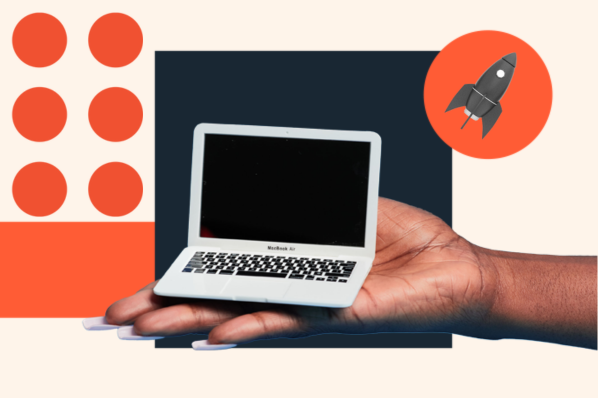The freemium model is a remedy to these high costs. It reduces the price of acquiring new customers by shifting the burden of product education from you to the customer.
In this post, we'll cover:
- The Definition of Freemium
- The Definition of the Freemium Model
- Freemium Model Examples
- Freemium vs. Free Trial
- How to Optimize your Freemium Conversion Rate
The main goal of a freemium acquisition model is to decrease your business' customer acquisition cost (CAC). By eliminating the cost to sign up for an account, you lower the bar to entry for new users to your product.
You also lower the amount you spend on paid marketing and sales processes.
Instead, you focus on building trust and highlighting the value of your product to free tier users even if the features are less.
After achieving success with your product, free tiered users can reach the limits of the free-level account and decide to invest in a premium account for more advanced access.
Since they've previewed your product, they already know the value you provide and aren't taking a risk on a product they haven't used.
Learn more about the freemium model in the video below.
Freemium Strategy
Successfully implementing a freemium acquisition model requires limitations on certain aspects of your product to differentiate between free and paid plans:
- Feature limitations: Offering extra features, enhanced functionality of features, or ad hoc paid upgrades (e.g. rare items in a game) for paid tiers.
- Usage quotas: Storage limits for free plans, monthly credits, and data processing quotas, showing the user what they can do with the product but leaving them wanting more.
- Limited support: Tiered access to customer service and support resources for each tier.
The limitations that you use for your product or service should leave users wanting more, but not so much that they don't see the core value of your product.
If you have a deep understanding of your customer's needs and the value you provide them, you'll be able to find a clear balance.
Freemium Advantages and Disadvantages
A freemium model helps lower CAC and the amount you spend on marketing, but it also has drawbacks.
Let's go over the pros and cons of the freemium model.
Pros of Freemium
- People are willing and interested in trying a new product or service for free. This can help you acquire a large set of initial users that you can nurture into paying customers.
- Free tiers are free, but you can still generate revenue from them by running ads.
- Your product's value drives acquisition, helping you lower customer acquisition costs.

Cons of Freemium
- Free users aren't guaranteed to convert to paid users.
- If you offer too many features in your free plan, users are not incentivized to upgrade to a paid plan because they've already leveraged your tools.
- If your free tier doesn't provide enough of a preview of your value, customers may drop off entirely because they can't figure out what you offer.
Now that you know what freemium is and how it works let's look at a few examples of how the freemium model is used in B2B and B2C companies.
To note, B2B products solve complicated business issues for organizations, and they're usually feature-rich with a steep price tag.
As a result, B2B companies often implement a freemium model that previews a product or service's value but leaves enough to be desired.
On the other hand, B2C products often take a simpler approach to freemium, and the groups that benefit the most from the strategy are mobile and web apps.
On to the examples.
1. HubSpot
HubSpot offers a free CRM platform with all the software, integrations, and resources you need to connect marketing, sales, content management, and customer service.
Using the freemium model, HubSpot users can access a host of features that are associated with its broader product suite for free — with more fully functional, upgraded products available for purchase.
The image below shows the details of the Free, Starter, and Professional tiers.

Get started with HubSpot for free
Limited Features
The free tier offers a set of foundational resources for marketing, sales, service, and operations. It also includes free CMS tools to help marketers and developers get started with creating or expanding a website.
However, the features are still limited as users are required to upgrade to the Starter plan to gain access to more comprehensive software systems.
Limited Usage
The free CRM tools don't include usage of the individual hubs (e.g., Marketing Hub). Free users also don't have the option to collaborate with additional users on their teams or add customer contacts like they would with an upgrade.
2. Zapier
Zapier is a B2B web application that allows users to connect different digital tools through sequences of automated triggers.
Its freemium model gives users a taste of what the product is capable of, and the image below displays the key feature differences between its free tier and paid starter tier.

Limited Features
New users only have five single-step Zaps, meaning that there can only be an initial trigger (e.g., a survey is submitted on Google Forms), and a subsequent task (the survey data is transferred to an email contact base).
After an upgrade, a user can do multi-step Zaps for more complex automation tasks. Zapier also has gated app integrations for Premium Apps, like PayPal or Facebook Ads, that are only available to premium users.
Limited Usage
In addition to gated features, Zapier places limits on usage on three different aspects of its platform:
- Zaps and Task Completions: Free users have 100 monthly task completions, and the numbers increase to 750 in the first paid tier.
- Synching Interval: Data synching for free users starts at 15 minutes and decreases as users upgrade to paid plans. Users needing faster data synching are inspired to upgrade for quicker synching for daily tasks.
- Number of Users: The number of people that can use a free account is limited, enticing those who need greater collaboration abilities to upgrade from the free plan.
What We Like
This is a beneficial strategy, as one single-step Zap demonstrates the power of the product sparks the user's interest. Plus, the premium integrations are very common, so there's a high chance users will end up wanting to upgrade.
3. Spotify
Spotify is a good example of how B2C companies use this model.
It's a music streaming app where users can play music from their preferred device, like songs, create and share playlists, and discover new music.
There's a free plan available, and the image below displays the premium plan offerings.
Limited Features
Spotify's free plan lets users stream most albums, playlists, and radio stations.
But they're served ads between songs, have a limited number of song skips per hour, and can't save music to listen to offline.
The first-tier premium plan affords users a deeper set of features for a richer experience. Plus, more features become available as the tiers increase.
Limited Usage
Spotify also limits product usage, and these limitations align with its features.
For example, free tier users are only allowed four skips an hour and can only listen to playlists on shuffle, interrupting the experience of those who like to listen to albums in order.
Both of these restrictions are eliminated with a premium upgrade.
Finally, as mentioned earlier, free users are served ads in between songs, but premium listening is ad-free.
What We Like
The feature limitations are heavy for free users, but they can still see the product's value. Things like running out of skips and ads interrupting a listening experience remind users of what they're missing out on without premium.
4. TuneIn
TuneIn is a freemium B2C app that lets users stream radio, podcasts, and live event broadcasts on various devices.
This includes their TV, computer, tablet, phone, or radio.
The image below shows the details of both the free and premium tiers.
Limited Features
The core difference between the free and premium plan is that users can't listen to live sports games across leagues or a wide selection of audiobooks.
Limited Usage
TuneIn also limits usage for free users by using display ads and commercials between songs, episodes, or broadcasts.
What We Like
The difference in perks between the free plan and the premium plan is a compelling way to activate free users. For music and podcast lovers, the premium plan is an encouraging upgrade that boasts listening without interruption.
5. Evernote (B2B/B2C)
Evernote is a note-taking and organizing app that allows users to write on the go by taking notes in notebooks that they can access across different devices.
Limited Features
Evernote's free features are limited to the basic functions of a virtual notebook.
The free plan also only allows users to get customer service through self-service forums, and they don't have access to collaborative notebooks or the ability to work offline in Evernote.
Limited Usage
Free users can also only sync across two devices. In our increasingly connected world, this difference can impact someone's workflow and their ability to record notes across different devices and collaborate with others.
The free plan also limits the maximum size of notes and the maximum amount of monthly uploads into Evernote.
What We Like
Anyone who wants access to anything beyond the basic notebook functionality is left wanting more. And once users get a taste of the free plan, they're more likely to upgrade to get the most out of Evernote.
Freemium vs. Free Trial
Now that we've gone over what freemium means and what it looks like in practice, you might be wondering, "why not just use a free trial?"
The right answer depends on your specific goals, target audience, and the type of product or service you provide.
Let's dive in.
Differences Between Freemium and Free Trial
Like freemium, free trials lower the cost of acquisition by letting the product or service speak for itself and do the work of converting leads to customers.
But, there are two ways freemium and free trials differ:
-
Freemium system free plans last forever, and free trials are for a limited time (e.g. one week).
-
Free trials give users complete access to all (or most) of a product's features; freemium users only have access to limited features.
These differences produce unique benefits and drawbacks for each system.
Benefits of the Free Trial Model
The most significant benefit of a free trial model is that you don't have to support casual users who don't generate direct revenue for your business.
Once the trial is over, they must sign up for a paid account or churn.
This can lead to higher product engagement rates as you're left with paid users, and these users are more likely to seek out and extract all the value that they can from your product since they're paying for it.
A higher product engagement rate leads to a longer customer lifetime, which translates to more revenue over time.
In addition, free trials can be more effective at converting users into paying clients as users get access to the full functionality of a product or service rather than the limited access that freemium provides.
Benefits of the Freemium Model
Free trials create pressure because they require a credit card to sign up, and the free period is only for a limited time.
Conversely, freemium creates a pressure-free environment for new users to explore a product without purchasing it before they're ready.
Freemium can also scale to your users' needs.
A customer might not need full functionality when they first sign up, but their needs will change as they grow.
And, since your product is already integrated into users' normal workflow, it can be more painful to switch to something else and start new as needs change.
Another benefit to freemium over a free trial is that it brings a higher volume of leads, which gives you more opportunity to reach a wider audience through word of mouth.
So, even if your free users aren't directly bringing in revenue, they could still be helping you grow by referring you to others in their network.
How to Optimize Your Freemium Conversion Rate
The goal of a freemium acquisition model is to increase paid subscribers, so its success can be measured by the rate at which people upgrade from a free plan to paid plan — or your conversion rate.

Given this, let's go over how you can optimize your freemium conversion rate.
1. Set the right product limitations for your free account.
If your freemium conversion rate is low, one of the first steps you can take is to look at your plan.
If you offer too many features and users get the full value from your free plan, there is less incentive to upgrade.
To get a sense of this, you can monitor data usage to see how customers use your product and where they're getting the most value.
This will help you decide which adjustments to make to ensure you're leaving enough of a value gap to create friction for users to recognize the benefits of upgrading.
2. Include a full-feature free trial.
You can get the best of both worlds by offering new users a full-featured free trial and a limited free-forever plan.
A combined approach can be effective because the two strategies complement each other. A full feature free trial lets new users explore the full functionality with no limitations, helping them understand the value.
If they're not ready to pay yet, they can transfer to the free plan to continue using your product or service. Losing access to full features can then help the user realize the true benefit of paying for your service and incentivize them to upgrade.
3. Focus on customer success.
Freemium models help products or services do the selling for you, so your free users must be able to quickly and easily discover the value of your products right when they sign up.
The best way to facilitate this is to optimize for customer success.
There are many things you can do to improve customer success, such as:
- Set customers up for success with a good welcome email or onboarding email series.
- Highlight important features with in-app prompts and notifications.
- Answer any potential questions with a comprehensive product knowledge base.
- Create an additional layer of support with a dedicated customer service team.
- Share tips and inspiration with new users by sending out a newsletter.
Whatever you do, ensure you're helping customers get more value out of your product. This can significantly increase the likelihood that free users will upgrade to a paid account.
4. Remind users to upgrade at every turn.
It's important to keep in mind that your users are real people, which means you can't expect them to pick up on subtle encouragement to upgrade their accounts.
Instead, you should remind users that they are on a limited plan and they have the option to upgrade to a paid version with fewer restrictions.
Some examples include:
- In-app notifications highlighting specific feature limitations for free users.
- Upgrade calls-to-action in your onboarding and support messages.
- Periodic email notifications to remind users what they could get from a paid plan.
The image below is an example of Evernote using this tactic, where users are notified that a search feature is only available to premium users.

These tactics can help convince users that are on the fence to take the final step and convert to a paid account to get access to the features they want.
You can take the last option a step further by tracking user behavior and using email segmentation to send targeted messages to users based on the features they use or notifications when they get close to usage limits.
5. Take a more hands-on approach to inside sales.
Creating an inside sales team can be another excellent way to get more out of a freemium acquisition model and increase freemium conversion rate for enterprise-level B2B products.
To create an effective inside sales strategy for your freemium product, you need to effectively identify high-priority leads so your team can follow up with them directly.
There are two ways that you can do this.
Based on Usage Patterns
- Implement a lead scoring model that tracks your users' behavior. Users who are close to the limits of your free plan or users who take advantage of many different features within your product will receive more points.
- Once a lead reaches a certain score, you can further qualify them with an automated process to gauge interest in upgrading, as well as revenue potential. From there, you can decide at what point your inside sales team should intervene.
Based on Third-Party Data
- Enrich the data in your CRM with third-party data to better understand who your high-revenue-potential users are.
- For example, you can look for potential enterprise leads that might be using your product tangentially (e.g., a regional sales office using your tool at a massive multinational organization).
Once you have qualified your leads, your inside sales representatives can contact the decision-makers and make the sale directly.
Over to You
Freemium can help you increase the acquisition potential of your product while simultaneously keeping your acquisition costs down.
To be successful, ensure you always focus on your customers and understand how they get value from your product. That way, so you create a plan that demonstrates the most value for them while also leaving them wanting more.
To learn more, read about the different stages of the SaaS customer lifecycle next.
Editor's note: This post was originally published in November 2018 and has been updated for comprehensiveness.
SaaS
.png?width=112&height=112&name=Image%20Hackathon%20%E2%80%93%20Vertical%20(45).png)













